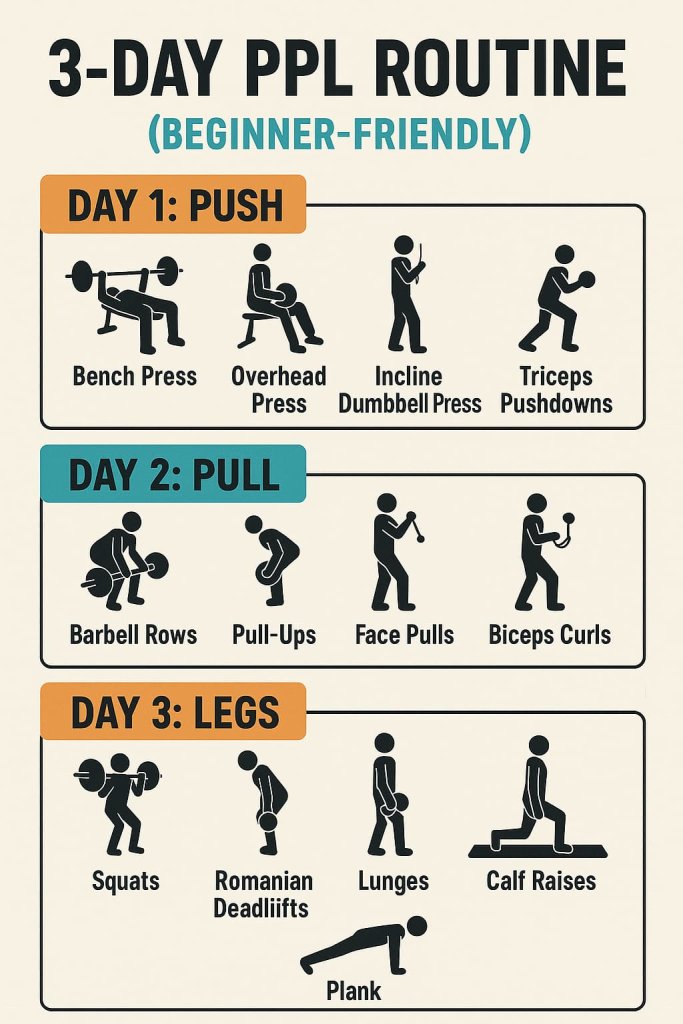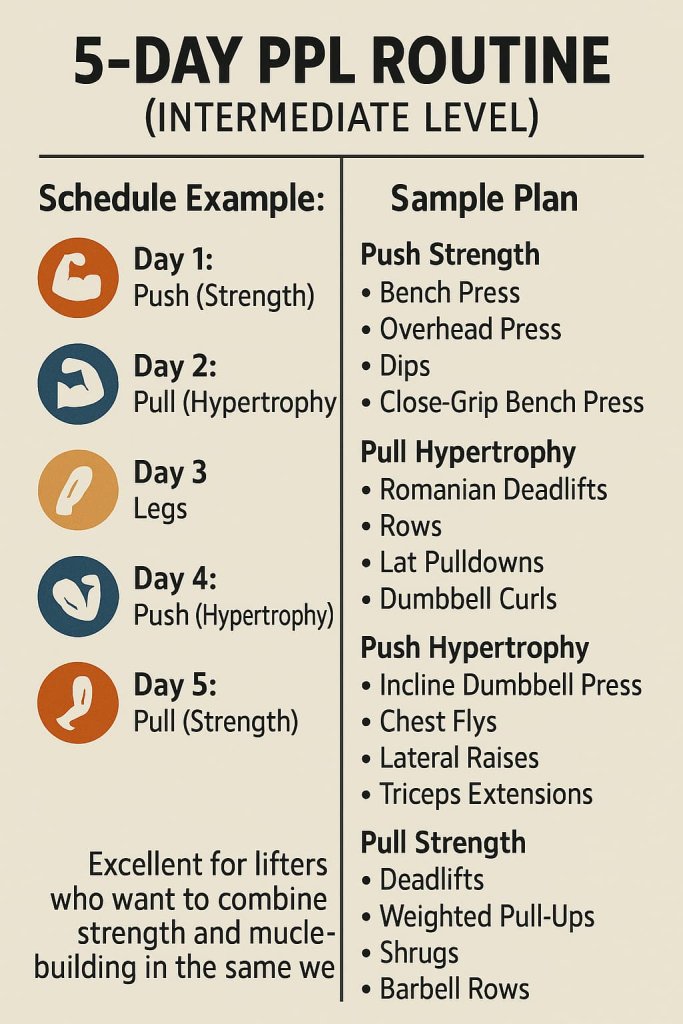The Push Pull Legs (PPL) workout routine is one of the most effective and science-backed training splits for building muscle and strength. It works by dividing your training into three categories: push, pull, and legs—ensuring balance, recovery, and progressive overload.

Understanding the PPL workout routine is crucial because it gives you flexibility (3, 5, or 6 days per week), allows you to train each muscle group 1–2 times weekly, and helps avoid common pitfalls of other programs like the “bro split.” According to BoxRox (2025), the PPL split remains one of the top training methods for hypertrophy because it hits muscles with enough frequency and volume.
In this detailed guide, we’ll cover:
- What the PPL routine is and why it works
- Beginner, intermediate, and advanced versions (3, 5, and 6-day splits)
- Example workouts and rep ranges
- Tips for success and mistakes to avoid
- FAQs answered with expert insights
- References to trusted fitness resources
What Is the PPL Split?
The Push Pull Legs routine organizes workouts into three main sessions:
- Push Day (Chest, Shoulders, Triceps): Bench Press, Overhead Press, Triceps Dips
- Pull Day (Back, Biceps, Rear Delts): Deadlifts, Rows, Pull-Ups, Biceps Curls
- Leg Day (Lower Body + Core): Squats, Lunges, Romanian Deadlifts, Calves, Abs
This split minimizes overlap between muscle groups, giving each enough recovery while maintaining effective training frequency. StrengthLog (2025) explains that PPL remains one of the most efficient ways to maximize both hypertrophy and strength.
Why Choose a PPL Workout Routine?
Key Benefits
- Science-Backed Frequency: Studies show training each muscle group twice per week leads to better hypertrophy than once-weekly programs (Outlift, 2025).
- Efficient Recovery: By grouping complementary muscles, PPL reduces fatigue and optimizes rest.
- Flexibility: Works with 3, 5, or 6-day schedules, making it suitable for beginners to advanced lifters.
- Balance of Compounds & Isolation: PPL integrates heavy lifts with accessory moves for full development.
- Sustainable Long-Term: Easy to scale up by adding sets, exercises, or extra training days.
PPL Workout Routine Versions
Below is a detailed look at 3-day, 5-day, and 6-day PPL splits.
3-Day PPL Routine (Beginner-Friendly)

Schedule:
- Day 1: Push
- Day 2: Pull
- Day 3: Legs
Sample Plan:
- Push: Bench Press, Overhead Press, Incline Dumbbell Press, Triceps Pushdowns
- Pull: Barbell Rows, Pull-Ups, Face Pulls, Biceps Curls
- Legs: Squats, Romanian Deadlifts, Lunges, Calf Raises, Plank
👉 Perfect for beginners or people with limited gym time. Each muscle group is trained once per week.
5-Day PPL Routine (Intermediate Level)

Schedule Example:
- Day 1: Push (Strength)
- Day 2: Pull (Hypertrophy)
- Day 3: Legs
- Day 4: Push (Hypertrophy)
- Day 5: Pull (Strength)
Sample Plan:
- Push Strength: Bench Press, Overhead Press, Dips, Close-Grip Bench Press
- Pull Hypertrophy: Romanian Deadlifts, Rows, Lat Pulldowns, Dumbbell Curls
- Legs: Squats, Hack Squats, Hamstring Curls, Calves, Hanging Leg Raises
- Push Hypertrophy: Incline Dumbbell Press, Chest Flys, Lateral Raises, Triceps Extensions
- Pull Strength: Deadlifts, Weighted Pull-Ups, Shrugs, Barbell Rows
👉 Excellent for lifters who want to combine strength and muscle-building in the same week.
6-Day PPL Routine (Advanced Lifters)
Schedule:
- Day 1: Push
- Day 2: Pull
- Day 3: Legs
- Day 4: Push
- Day 5: Pull
- Day 6: Legs
- Day 7: Rest
Sample Plan:
- Push: Bench Press, Overhead Press, Incline Press, Dumbbell Flys, Triceps Pushdowns
- Pull: Deadlift, Barbell Rows, Pull-Ups, Face Pulls, Hammer Curls
- Legs: Squats, Bulgarian Split Squats, Romanian Deadlifts, Calf Raises, Ab Rollouts
👉 Best for advanced lifters aiming for maximum hypertrophy, with each muscle trained twice per week.
Comparison Table: PPL Workout Splits
| Training Frequency | Best For | Benefits | Limitations |
|---|---|---|---|
| 3-Day (1×/week) | Beginners / Busy Schedules | Simple, lots of recovery | Lower frequency per muscle |
| 5-Day | Intermediate Lifters | Balanced strength + hypertrophy | More time commitment |
| 6-Day (2×/week) | Advanced Lifters | Maximum growth & frequency | Higher recovery demands |
Tips for Success in PPL Training
- Follow Progressive Overload: Increase weights/reps weekly to avoid plateaus.
- Stick to Rep Ranges: 6–12 reps for hypertrophy, 3–6 for strength.
- Nutrition Matters: Eat enough calories and 1.6–2.2g protein/kg body weight daily (Dr. Muscle, 2025).
- Sleep & Recovery: Aim for 7–9 hours per night, plus at least 1 rest day weekly.
- Don’t Skip Legs: Builds balance and prevents strength imbalances.
- Track Progress: Use apps or a workout log to measure improvements.
Common Mistakes to Avoid
- Overtraining: Jumping into a 6-day split without proper rest.
- Poor Form: Rushing through heavy lifts leads to injury.
- Neglecting Warm-Ups & Mobility: Increases joint strain.
- No Deload Weeks: Causes long-term fatigue and stagnation.
- Skipping Nutrition: Training without proper fuel limits results.
Frequently Asked Questions (FAQs)
1. Is PPL good for beginners?
Yes—start with a 3-day split. Once consistent, progress to 5 or 6 days.
2. Can I build muscle with just PPL?
Absolutely. PPL is one of the most effective hypertrophy-focused splits.
3. How long should a PPL workout last?
Around 60–75 minutes per session is ideal.
4. Can I add abs to PPL?
Yes, include ab work at the end of push or pull days.
5. Is PPL better than full body?
Both work. Full body is great for beginners; PPL is superior for progression.
6. Can I mix cardio with PPL?
Yes—add low-intensity cardio on rest days or after lifting sessions.
7. How long should I stick with PPL?
At least 8–12 weeks before making major changes.
Conclusion
The Push Pull Legs (PPL) workout routine is one of the most efficient and time-tested training splits for building strength and muscle. Whether you train 3, 5, or 6 days a week, the PPL system offers flexibility, balanced muscle targeting, and proven results.
If you’re a beginner—start with a 3-day routine. As you advance, move to 5 or 6 days for maximum gains. Remember: success depends on consistency, progressive overload, recovery, and nutrition.
👉 Commit to a PPL routine, track your progress, and watch your physique transform week by week.
